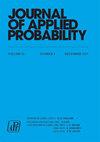一类各向异性泊松线镶嵌中三角形的比例
IF 0.7
4区 数学
Q3 STATISTICS & PROBABILITY
引用次数: 1
摘要
研究了平面上直线的平稳泊松过程,其方向分布集中在$k\geq3$等展开方向上。这种过程的随机线将平面分解为一组随机多边形,形成所谓的泊松线镶嵌。本文的重点是确定这种镶嵌中三角形的比例,或者等效地,确定典型单元为三角形的概率。作为副产品,通过近似论证获得了各向同性情况下Miles经典结果的新偏差。本文章由计算机程序翻译,如有差异,请以英文原文为准。
The proportion of triangles in a class of anisotropic Poisson line tessellations
Stationary Poisson processes of lines in the plane are studied, whose directional distributions are concentrated on
$k\geq 3$
equally spread directions. The random lines of such processes decompose the plane into a collection of random polygons, which form a so-called Poisson line tessellation. The focus of this paper is to determine the proportion of triangles in such tessellations, or equivalently, the probability that the typical cell is a triangle. As a by-product, a new deviation of Miles’s classical result for the isotropic case is obtained by an approximation argument.
求助全文
通过发布文献求助,成功后即可免费获取论文全文。
去求助
来源期刊

Journal of Applied Probability
数学-统计学与概率论
CiteScore
1.50
自引率
10.00%
发文量
92
审稿时长
6-12 weeks
期刊介绍:
Journal of Applied Probability is the oldest journal devoted to the publication of research in the field of applied probability. It is an international journal published by the Applied Probability Trust, and it serves as a companion publication to the Advances in Applied Probability. Its wide audience includes leading researchers across the entire spectrum of applied probability, including biosciences applications, operations research, telecommunications, computer science, engineering, epidemiology, financial mathematics, the physical and social sciences, and any field where stochastic modeling is used.
A submission to Applied Probability represents a submission that may, at the Editor-in-Chief’s discretion, appear in either the Journal of Applied Probability or the Advances in Applied Probability. Typically, shorter papers appear in the Journal, with longer contributions appearing in the Advances.
 求助内容:
求助内容: 应助结果提醒方式:
应助结果提醒方式:


